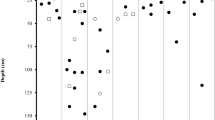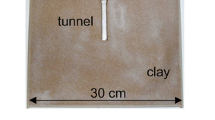Abstract
Besides the excavation of underground nest chambers, Atta vollenweideri grass-cutting ants build ventilation turrets on the topmost openings of their huge nests. Turret construction was studied in a laboratory colony, addressing the question whether turrets are simply heaps of disposed soil, or result from the import and a particular spatial arrangement of materials. The colony was daily offered different building materials, i.e., clay, coarse and fine sands, which workers collected and deposited around a nest opening to construct a turret. After 10 days, the spatial arrangement of the different building materials, offered either simultaneously or consecutively in independent experiments, was characterized via thin sections and micromorphological analysis of the turret’s walls. Workers did not select particular materials to be imported for turret building, but were selective in their spatial distribution and assembly into the turret structure. Particular types of microstructures were observed depending on the available materials, such as simple piles of sands, porous fabrics only composed of clay pellets, or fabrics with clay and sands combined. Turrets were very dynamic structures: while most imported materials were initially piled up at the shortest distance from the source, a marked subsequent material redistribution occurred as the turret grew, resulting in a new, mixed structure. Material re-assembly was particular evident when clay and sands were offered consecutively: a remarkable tendency to construct microstructures combining both materials was observed, i.e., clays were mobilized and included in sandy walls, and sands were intercalated in much compact clay walls. Irrespective of the materials used, walls showed a marked regular porosity in the range 50–60%, with the exception of secondary galleries that occasionally permeated the turret structure, which evinced lower porosity and therefore a more compact microstructure. Ants appeared to respond to local variations in the structural stability of the construction, since clay coatings smoothed and reinforced the surface of unstable sandy gallery walls. The observed building responses appear to be aimed at the maintenance of a porous yet mechanically-stable structure. The attained turret porosity may represent a compromise between high structural stability and low construction costs because of savings in material import.






Similar content being viewed by others
References
Aleksiev AS, Longdon B, Christmas MJ, Sendova-Franks AB, Franks NR (2007a) Individual choice of building material for the nest construction by worker ants and the collective outcome for the colony. Anim Behav 74:559–566
Aleksiev AS, Sendova-Franks AB, Franks NR (2007b) The selection of building material for wall construction by ants. Anim Behav 73:779–788
Autuori M (1947) Contribuição para o conhecimento da saúva (Atta spp. Hymenoptera–Formicidae). IV. O saúveiro depois da primeira revoada (Atta sexdens rubropilosa Forel, 1908). Inst Biol 18:39–70
Bahadori MN (1978) Passive cooling systems in Iranian architecture. Sci Am 238:144–154
Bollazzi M, Kronenbitter J, Roces F (2008) Soil temperature, digging behaviour, and the adaptive value of nest depth in South American species of Acromyrmex leaf-cutting ants. Oecologia 158:165–175
Bollazzi M, Roces F (2007) To build or not to build: circulating dry air organizes collective building for climate control in the leaf-cutting ant Acromyrmex ambiguus. Anim Behav 74:1349–1355
Bollazzi M, Roces F (2010a) Control of nest water losses through building behavior in leaf-cutting ants (Acromyrmex heyeri). Insectes Soc 57:267–273
Bollazzi M, Roces F (2010b) Leaf-cutting ant workers (Acromyrmex heyeri) trade off nest thermoregulation for humidity control. J Ethol 28:399–403
Bollazzi M, Roces F (2010c) The thermoregulatory function of thatched nests in the South American grass-cutting ant Acromyrmex heyeri. J Insect Sci 10:137, available at: insectscience.org/10.137
Bullock PN, Fedoroff A, Jongerius G, Stoops G, Tursina T (1985) Handbook for soil thin section description. Waine Research Publications, Albrighton
Cassill DL, Tschinkel WR, Vinson SB (2002) Nest complexity, group size and brood rearing in the fire ant, Solenopsis invicta. Insectes Soc 49:158–163
Cosarinsky M (2006) Nest micromorphology of the neotropical mound building ants Camponotus punctulatus and Solenopsis sp. Sociobiol 47:329–344
Cosarinsky M, Roces F (2007) Neighbor leaf-cutting ants and mound-building termites: comparative nest micromorphology. Geoderma 141:224–234
Currie JA (1984) Gas diffusion through soil crumbs: the effects of compaction and wetting. J Soil Sci 35:1–10
Dejean A, Lachaud J-P (1994) Ecology and behavior of the seed-eating ponerine ant Brachyponera senaarensis (Mayr). Insectes Soc 41:191–210
Espinoza DN, Santamarina JC (2010) Ant tunneling—a granular media perspective. Granular Matter 12:607–616
Fitzpatrick EA (1984) Micromorphology of soils. Chapman and Hall, New York
Gorosito NB, Curmi P, Hallaire V, Folgarait PJ, Lavelle PM (2006) Morphological changes in Camponotus punctulatus (Mayr) anthills of different ages. Geoderma 132:249–260
Hansell MH (2005) Animal architecture. Oxford University Press, Oxford
Howse PE (1966) Air movement and termite behaviour. Nature 210:967–968
Jonkman JCM (1980a) The external and internal structure and growth of nests of the leaf-cutting ant Atta vollenweideri Forel, 1893 (Hym.: Formicidae). Part I. Z Ang Ent 89:158–173
Jonkman JCM (1980b) The external and internal structure and growth of nests of the leaf-cutting ant Atta vollenweideri Forel, 1893 (Hym.: Formicidae). Part II. The internal nest structure and growth. Z Ang Ent 89:217–246
Jouquet P, Lepage M, Velde B (2002) Termite soil preferences and particle selections: strategies related to ecological requirements. Insectes Soc 49:1–7
Kleineidam C, Ernst R, Roces F (2001) Wind-induced ventilation of the giant nests of the leaf-cutting ant Atta vollenweideri. Naturwissenschaften 88:301–305
Kleineidam C, Roces F (2000) Carbon dioxide concentrations and nest ventilation in nests of the leaf-cutting ant Atta vollenweideri. Insectes Soc 47:241–248
Korb J (2003) Thermoregulation and ventilation of termite mounds. Naturwissenschaften 90:212–219
LeBrun EG, Moffett M, Holway DA (2011) Convergent evolution of levee building behavior among distantly related ant species in a floodplain ant assemblage. Insectes Soc 58:263–269
MacKay WP, MacKay EE (1985) Temperature modifications of the nest of Pogonomyrmex montanus (hymenoptera: formicidae). Southwest Nat 30:307–310
McCook HC (1877) Mound-making ants of the Alleghenies, their architecture and habits. Trans Amer Ent Soc 6:253–296
McCook HC (1879) On the architecture and habits of the cutting ant of Texas (Atta fervens). Ann Mag Nat Hist 3:442–449
Moreira AA, Forti LC, de Andrade APP, Boaretto MAC, Lopes JFS (2004) Nest architecture of Atta laevigata (F. Smith, 1858) (Hymenoptera: Formicidae). Stud Neotrop Fauna Environ 39:109–116
Murphy CP (1986) Thin section preparation of soils and sediments. A. B. Academic Publishers, London
Navarro JG, Jaffé K (1985) On the adaptive value of nest features in the grass-cutting ant Acromyrmex landolti. Biotropica 17:347–348
Ribeiro PL, Navas CA (2008) Colony dehydration and water collection by specialized caste in the leaf-cutting ant Atta sexdens rubropilosa. J Insect Behav 21:549–558
Robinson EJH, Holcombe M, Ratnieks FLW (2008) The organization of soil disposal by ants. Anim Behav 75:1389–1399
Schelter M (2009) Energetik des Grabverhaltens von Blattschneiderameisen. In: Diploma-Thesis, Fakultät für Biologie, Julius-Maximilians-Universität Würzburg, Germany, pp 48
Scherba G (1962) Mound temperatures of the ant Formica ulkei emery. Am Midl Nat 67:373–385
Sleeman JR, Brewer R (1972) Micro-structure of some Australian termite nests. Pedobiol 12:347–373
Smith CR, Tschinkel WR (2005) Object depots in the genus Pogonomyrmex: exploring the “who”, what, and where. J Insect Behav 18:859–879
Stoops G (1964) Application of some pedological methods to the analysis of termite mounds. In: Bouillon A (ed) Études sur les termites Africains. Edition de l’Université, University of Leopoldville, Leopoldville, pp 379–398
Stoops G (2003) Guidelines for analysis and description of soil and regolith thin sections. Soil Science Society of America, Madison
Sudd JH (1982) Ants: foraging, nesting, brood behavior, and polyethism. In: Hermann HR (ed) Social insects, vol IV. Academic, New York, pp 107–155
Toffin E, Kindekens J, Deneubourg JL (2010) Excavated substrate modulates growth instability during nest building in ants. Proc R Soc Lond B 277:2617–2625
Tofilski A, Ratnieks FLW (2005) Sand pile formation in Dorymyrmex ants. J Insect Behav 18:505–512
Tschinkel WR, Bhatkar A (1974) Oriented mound building in the ant, Trachymyrmex septentrionalis. Environ Entomol 3:667–673
Wang D, McSweeney K, Lowery B, Norman JM (1995) Nest structure of ant Lasius neoniger emery and its implications to soil modification. Geoderma 66:259–272
Weber NA (1972) Gardening ants—the attines. The American Philosophical Society, Philadelphia
Wehner R (1970) Ètudes sur la construction des cratères au-dessus des nids de la fourmi Cataglyphis bicolor (Hymenoptera, Formicidae). Insectes Soc 17:83–94
Wheeler WM (1907) The fungus-growing ants of North America. Bull Am Mus Nat Hist 23:669–807
Whitford WG (2003) The functional significance of cemented nest caps of the harvester ant, Pogonomyrmex maricopa. J Arid Environ 53:281–284
Acknowledgements
Special thanks are due to Annette Laudahn, Martin Bollazzi and Oliver Geissler for valuable help during the experiments. We are also indebted to Alejandro G. Di Giacomo and the Götz family for providing facilities at the Reserva Ecológica El Bagual (Alparamis SA—Aves Argentinas) in Formosa, Argentina, where preliminary field experiments were performed. This study was performed at the Univ. of Würzburg during a research visit of the first author, supported by funds from the German Research Foundation (DFG, grant SFB 554/TP E1).
Author information
Authors and Affiliations
Corresponding author
Rights and permissions
About this article
Cite this article
Cosarinsky, M.I., Roces, F. The Construction of Turrets for Nest Ventilation in the Grass-Cutting Ant Atta vollenweideri: Import and Assembly of Building Materials. J Insect Behav 25, 222–241 (2012). https://doi.org/10.1007/s10905-011-9290-8
Revised:
Accepted:
Published:
Issue Date:
DOI: https://doi.org/10.1007/s10905-011-9290-8




